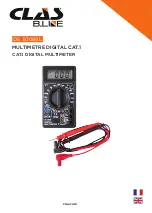
Diode test:
Test current: 1.0 mA max.,
Test voltage
1,5
V DC max.
Continuity test:
acoustic signal with resistances
< approx. 80 Ohm ±20 Ohm
Transistor test range ..............: hFE 0 - 1000 „ß“
Base current ..........................: approx. 10 µA
VCE (UCE).............................: max.
1,5
V
Maximum input quantities, overload protection
Voltage measurement .............: 600 VDC or VACrms
Current measurement .............: 10 A DC and 10 A AC in the res-
pective 10 A measuring range, un-
fused, 10 s duration maximum,
with a subsequent cooling phase of
at least 15 min., 35 V DC
400mA AC/DC in mA range,
max. 250 V DC/V AC rms,
overload protection A 250V
quick-blow ceramic fuse
(size: 5 x 20 mm)
Resistance measurement........: 40 MOhm,
overload protection :
2
5
0 V DC/AC rms
Diode test................................: Overload protection:
2
5
0 V DC/VAC rms
Continuity test .........................: Overload protection:
2
5
0 V DC/VAC rms
The transistor test feature is not protected against
overload or excessive input voltage(s).
Exceeding the maximum permitted input levels can
damage the measuring instrument and/or endanger
the life of the user.
46
• Only use the test leads which are supplied with the measuring
instrument for measurements. No others may be used
• To avoid electric shock, care should be taken that the test pro-
bes and the connections (measurement points) are not touched
during measurement, not even indirectly.
• The voltage between the V/Ohm socket of the measuring instru-
ment and ground may not exceed 300 V DC/V AC rms (CAT II =
Overvoltage Category 2)
• The measuring instrument should not be used in areas or under
adverse environmental conditions in which inflammable gas, fu-
mes or dust are present or can occur. For your own safety it is
essential to prevent the measuring instrument or its leads beco-
ming damp or wet. Avoid operation in the immediate vicinity of
- strong electromagnetic fields (loudspeakers or magnets)
- electromagnetic fields (transformers, motors, coils, relays,
contactors, electromagnets, etc.)
- electrostatic fields (charge/discharge)
- transmission aerials or HF generators
• If it can be assumed that safe operation is no longer possible,
then the unit must be switched off and protected against unin-
tentional operation. It can be assumed that safe operation is no
longer possible if
- the instrument shows visible signs of damage
- the unit no longer functions and
- after prolonged storage under unfavourable conditions or
- after severe transportation stress
• Never switch the instrument on immediately after it has been
brought from a cold into a warm area. The resultant condensati-
on water could damage the instrument. Allow the instrument to
come to room temperature before switching it on.
31












































